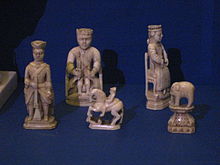
Back Vori de morsa Catalan Hvalroselfenben Danish Walrosselfenbein German Ivoire de morse French Tuugaaq Inupiak Rostungstönn Icelandic Walrusivoor Dutch




Walrus ivory, also known as morse,[1] comes from two modified upper canines of a walrus. The tusks grow throughout life and may, in the Pacific walrus, attain a length of one metre.[2] Walrus teeth are commercially carved and traded; the average walrus tooth has a rounded, irregular peg shape and is approximately 5 cm in length.
The tip of a walrus tusk has a tooth enamel coating which is worn away during the animal's youth. Fine longitudinal cracks, which appear as radial cracks in cross-section, originate in the cementum and penetrate the dentine. These cracks can be seen throughout the length of the tusk. Whole cross-sections of walrus tusks are generally oval with widely spaced indentations. The dentine is composed of two types: primary dentine and secondary (often called osteodentine). Primary dentine has a classical ivory appearance. Secondary dentine is marble or oatmeal-like.
- ^ Williamson, 9, an archaic term for the animal, but which survived much longer as a term for the ivory, though it too is now old-fashioned.
- ^ Nasoori, A (2020). "Tusks, the extra-oral teeth". Archives of Oral Biology. 117. doi:10.1016/j.archoralbio.2020.104835. PMID 32668361. S2CID 220585014.
© MMXXIII Rich X Search. We shall prevail. All rights reserved. Rich X Search